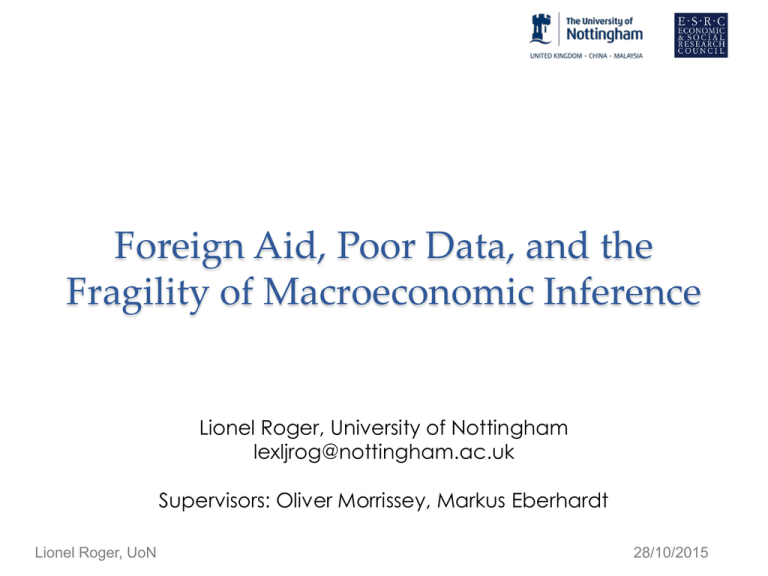Lionel Roger
advertisement

Foreign Aid, Poor Data, and the Fragility of Macroeconomic Inference Lionel Roger, University of Nottingham lexljrog@nottingham.ac.uk Supervisors: Oliver Morrissey, Markus Eberhardt Lionel Roger, UoN 28/10/2015 Aid Effectiveness? Effectiveness Lionel Roger, UoN Harmfulness 28/10/2015 Aid Effectiveness Savings Investment Foreign Exchange Economic Growth Public Investment Foreign Aid Lionel Roger, UoN 28/10/2015 Aid Harmfulness Market Distortions Foreign Aid Investment Economic Growth Corruption Lionel Roger, UoN 28/10/2015 Cointegrated VAR 𝑔𝑑𝑝𝑡 Possible Equilibria 𝑎𝑖𝑑𝑡 Figure 1: Pushing and pulling forces Lionel Roger, UoN 28/10/2015 Juselius, Møller & Tarp (2014) • Cointegrated VAR analysis for 36 African countries • Individual model for each country Effectiveness Harmfulness GDP 17 6 Investment 24 5 Either 27 10 Table 1: Summary of Results, Juselius, Møller & Tarp (2014) Lionel Roger, UoN 28/10/2015 Data matters ~ x 3.3 ~ x 2.5 Figure 2: GDP from 4 sources, normalised to 1965 Lionel Roger, UoN 28/10/2015 Data matters Figure 3: Investment share from 4 sources Lionel Roger, UoN 28/10/2015 Replication • 4 sources of data o Penn World Table versions 6.3, 7.1, 8.0 (Heston et. al, 2009, 2012; Feenstra et al. 2015) o World Development Indicators (The World Bank, 2015) Replication Alternative Datasets PWT6 PWT7 PWT8 WDI Inference 97% 67% 61% 77% Consistent Coefficients 88% 63% 58% 63% Reversed Coefficients 5% 28% 26% 12% Effectiveness 26 18 13 6 Harmfulness 10 9 7 3 Sample 36 36 33 13 Table 2: Replication results Lionel Roger, UoN 28/10/2015 Re-Specification • Idea: “allow the data to speak freely” • Sub-sample: 4 most and 4 least consistent countries o Consistent: Burkina Faso, Cameroon, Gabon, Kenya o Inconsistent: Benin, Lesotho, Mauretania, Togo • Re-specification of country-specific models for each dataset: 32 CVAR models • Variable elements: o Lag length: Lag-reduction test, Information Criteria, tests for autocorrelation o Equilibrium relations: Trace test, t-ratios of alpha-coefficients, roots of the companion matrix, graphical analysis o Extraordinary events: Inspection of residuals, institutional knowledge (conflicts, cataclysms, historical events, etc.) Lionel Roger, UoN 28/10/2015 Re-specification: Results PWT6 PWT7 PWT8 WDI Consistent Consistent Coeff. Inference Effect. Harmf. Effect. Harmf. Effect. Harmf. Effect. Harmf. Burkina Faso 0 0 0 - 0 0 0 - 63% 4 Cameroon 0 0 0 0 0 0 0 - 79% 5 Gabon 0 0 0 0 0 0 0 0 71% 6 Kenya + + + + + + + + 58% 6 Benin + - + - + 0 0 - 46% 4 Lesotho + + - - + 0 0 - 13% 1 Mauretania + 0 0 - 0 - - - 33% 0 Togo + 0 + - + - + + 25% 3 GDP 3 1 3 2 3 1 2 3 Investment 4 1 2 4 3 1 2 3 Either 5 1 3 5 4 2 2 5 Table 3: Results, Re-specified models Lionel Roger, UoN 28/10/2015 Conclusions • Macroeconomic data can vary a lot from source to source • The differences can matter a lot for the inference • ~1/3 of Results change in qualitative manner with new data • Variation is exacerbated when models are allowed to vary with data • But: Most countries’ results remain stable • Robustness checks should become standard • Highlights importance of understanding beyond statistical analysis Lionel Roger, UoN 28/10/2015



